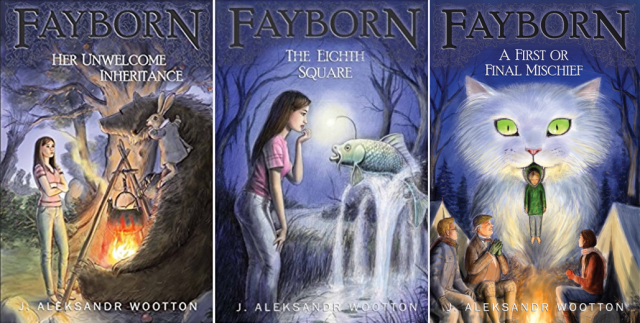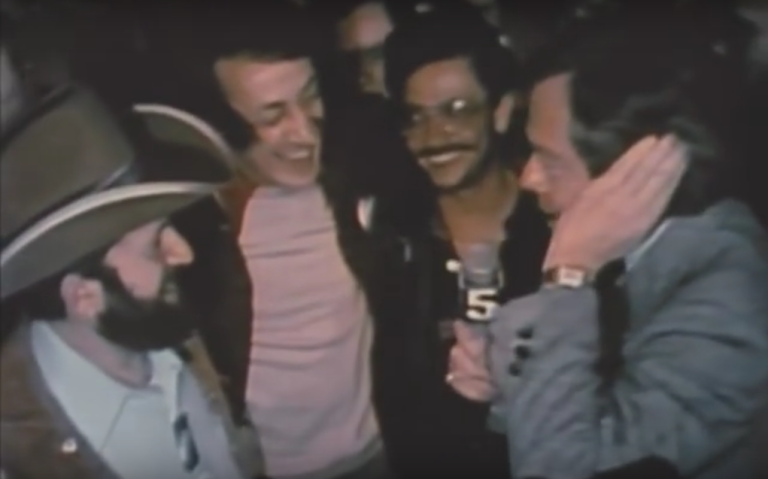 In tales where a child or young adult is going to save the world, the hero-in-waiting is usually withering away in obscurity, knowing they were meant for so much more but spending their lives doing homework, harvesting cabbages, working fast food, or doing whatever mundane and meaningless chore is before them. Petra Godfellow, though, would prefer to be left entirely on her own. Petra would like nothing more than to crack books and make friends at Lightfoot College, while missing her family back home and having coffee at one of the more remarkable coffee shops on the East coast.
In tales where a child or young adult is going to save the world, the hero-in-waiting is usually withering away in obscurity, knowing they were meant for so much more but spending their lives doing homework, harvesting cabbages, working fast food, or doing whatever mundane and meaningless chore is before them. Petra Godfellow, though, would prefer to be left entirely on her own. Petra would like nothing more than to crack books and make friends at Lightfoot College, while missing her family back home and having coffee at one of the more remarkable coffee shops on the East coast.
Languid literary hours in rootsy, hipster cafes, however, is not an option for Petra. Unwelcome as it may be, Petra has an inheritance that must be accounted for. Despite her mother and aunt’s attempt to hide Petra from her dangerous family history, the past finds Petra as she comes of age. Unlike adventure tales where an unheroic soul might shrug off the quest, choosing to live life without fame or fortune or magic swords, Petra’s quest is forced upon her.
 As her American suburban alt-life carries on without her, the myriad worlds of faërie squeeze their way into Petra’s campus reality. Far from the soft-edged, water-colour dreamy pastels of Disneyfied fairyland adventures, the fay-world of Petra’s unknown past is dark and dangerous. Petra is at the centre of an international, inter-generational, multi-dimensional play for power. If it is not enough that a vampyric fay mafia seeks to imprison her in a lifetime trade, but her faërie allies also have a stake in the magical cold war that could erupt into destruction at any moment. Petra is in danger on every side, with lives and communities far greater than her own at stake. Knowing who to trust is nearly impossible.
As her American suburban alt-life carries on without her, the myriad worlds of faërie squeeze their way into Petra’s campus reality. Far from the soft-edged, water-colour dreamy pastels of Disneyfied fairyland adventures, the fay-world of Petra’s unknown past is dark and dangerous. Petra is at the centre of an international, inter-generational, multi-dimensional play for power. If it is not enough that a vampyric fay mafia seeks to imprison her in a lifetime trade, but her faërie allies also have a stake in the magical cold war that could erupt into destruction at any moment. Petra is in danger on every side, with lives and communities far greater than her own at stake. Knowing who to trust is nearly impossible.
And they have her mother and her aunt–even though Petra isn’t quite certain who “they” are.
J. Aleksandr Wootton‘s Fayborn trilogy has been, for me, a delightful find and a truly three-dimensional read. I’ll talk about the imaginative world in a moment, but if we are to be honest it is the characters that keep us turning pages in fantastic fiction. Whether reprised from the past or taken from Prof. Wootton’s storied imagination, the central dozen or so characters pin me to the page. I am won over by the skeptical Petra Godfellow as the slow reality of fairyland emerges just inches from her doubtful eyes. Her family–and her increasingly important adoptive family slash Scooby gang–are not mere supports for the messiah-princess in her plastic journey to the end. All heroes are limited in the trilogy, including Petra and the mentors in her life. No one ever has enough knowledge, enough strength, enough magic, enough skill, or–though we won’t know until the end–enough luck.
 That these characters dance upon a stage of incredible imaginative scope is what makes the series an essential book for lovers of legend and folktale. The magic isn’t just in the central heroes and villains, but also in the dozens (hundreds?) of characters that they meet on the way. If we ask about the speculative structure of Fayborn, we can answer simply: it is just faërie, largely as it comes to us in our Euro-American tradition. Yet that description is so inadequate. Wootton’s work is pastiche at its greatest. It is a respectful imaginative collection of cultural folklore exceeded only by Neil Gaiman’s American Gods project. Even though I struggled at times with the sheer breadth of the project, I love the literary links.
That these characters dance upon a stage of incredible imaginative scope is what makes the series an essential book for lovers of legend and folktale. The magic isn’t just in the central heroes and villains, but also in the dozens (hundreds?) of characters that they meet on the way. If we ask about the speculative structure of Fayborn, we can answer simply: it is just faërie, largely as it comes to us in our Euro-American tradition. Yet that description is so inadequate. Wootton’s work is pastiche at its greatest. It is a respectful imaginative collection of cultural folklore exceeded only by Neil Gaiman’s American Gods project. Even though I struggled at times with the sheer breadth of the project, I love the literary links.
And the links are echoed in the narrative. Petra, her aunt, her roommate, and her motley crew move through the physical and speculative geographies of their worlds as the reader encounters the stories themselves. Readers experience urban fantasy erupting on campus, treks into the American tales of the Appalachian mountains, a visit to London tower lost in time, an airport terrorist incident, underground journeys and transdimensional travel both willing and accidental, and the long walk through the forest to the fairy castle (or to war). Even the travel itinerary is a kind of crossing of a threshold: we begin in the United States, but travel first to England and then into the heart of Europe, to the bare, cold forests where the thin line between fairy and human civilizations ripples in the evening air. Haven’t our legends and folktales come to us by exactly the opposite route?
 I am a lover of threshold fantasy, where the temenos between worlds blurs and even, for moments, disappears. The suspension of disbelief is not for me one of believing that there are magical creatures in the dormroom down the hall or in the dimensions that are echoed in the looking glass. Our modern world is so desperately aggregate–where we know the statistical probability of every dream-crushing possibility. What are the chances that he’ll find lifelong true love, or that she can really make a difference in politics, or that you will get your stories to print? The answer to this question is not merely the courage of the human heart and the integrity of moral choices–or even a cruel kind of fate–but can fit neatly on a chart with the statistical probability attached in a footnote. Our lives are data-bound, and stories like the Fayborn series invite us into an imaginative literary rebellion from the reductionism of our age.
I am a lover of threshold fantasy, where the temenos between worlds blurs and even, for moments, disappears. The suspension of disbelief is not for me one of believing that there are magical creatures in the dormroom down the hall or in the dimensions that are echoed in the looking glass. Our modern world is so desperately aggregate–where we know the statistical probability of every dream-crushing possibility. What are the chances that he’ll find lifelong true love, or that she can really make a difference in politics, or that you will get your stories to print? The answer to this question is not merely the courage of the human heart and the integrity of moral choices–or even a cruel kind of fate–but can fit neatly on a chart with the statistical probability attached in a footnote. Our lives are data-bound, and stories like the Fayborn series invite us into an imaginative literary rebellion from the reductionism of our age.
There is much to love about this series. Prof. Wootton is a sharp and terrifyingly efficient writer. The creative appropriation of dozens of storylines with its hundreds of references—of which I’m sure I only got a few—makes for a delightful series. And yet it is a very short trilogy. It is usually a good sign when readers want more, but I do think that this complex tale needs some conceptual maps to help the reader. Maps of the terrain would help, as well as a character tree of some kind. These items could actually increase the authenticity of the piece, supplemented as it is with letters and an inside-outside point of view. I truly think that Ninepin Town could be one of the great inventions of American fantasy, and the Fayborn world could use more of its speculative framework supplied for the reader.

I don’t want to spoil any aspect of the series, so I will merely say that the ending is an elegant solution to an impossible problem. I find myself liking the imperfect resolution—the irresolution, I guess—of this (un?)fairy tale that can’t end as neatly as they do in storybooks and Disney films. There is blood. There is darkness where there was light. All trust, or almost all, is betrayed–and wishful thinking won’t make it go away no matter how hard the characters (or the readers) try.
The splicing of legend and life will win story lovers from the very first chapter. It is as heavily footnoted in history and legend as Neil Gaiman, Guy Gavriel Kay, and Holly Black, but has an innocence and philosophical depth that is unique to Wooton’s work and world. In the trilogy, Prof. Wootton takes up every story: the central theme of the Fayborn series is that all stories are one and all are engaged in telling that one story. It is a lesson that is true, I believe, beyond the covers of the Fayborn series.
I had to wait patiently over five years as each book of the trilogy released. I took the desperate step of becoming a beta reader of the third volume so I could see it before the general public. I’m pleased to say that the final volume, A First or Final Mischief, dropped on the weekend, so make sure you pick it. The entire series is only about $12 on Kindle and will delight imaginative readers from the early teen years and older.
Advertisements If you like it, please share it:




